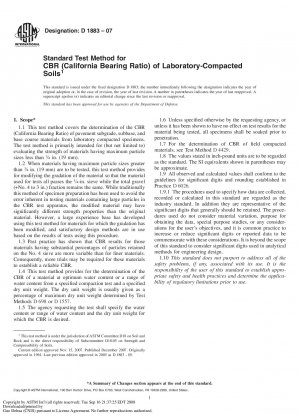ASTM D1883-07
Standard Test Method for CBR (California Bearing Ratio) of Laboratory-Compacted Soils
- Standard No.
- ASTM D1883-07
- Release Date
- 2007
- Published By
- American Society for Testing and Materials (ASTM)
- Status
- Replace By
- ASTM D1883-07e1
- Latest
- ASTM D1883-21
- Scope
1.1 This test method covers the determination of the CBR (California Bearing Ratio) of pavement subgrade, subbase, and base course materials from laboratory compacted specimens. The test method is primarily intended for (but not limited to) evaluating the strength of materials having maximum particle sizes less than 3/4 in. (19 mm).
1.2 When materials having maximum particle sizes greater than 3/4 in. (19 mm) are to be tested, this test method provides for modifying the gradation of the material so that the material used for tests all passes the 3/ 4-in. sieve while the total gravel (+No. 4 to 3 in.) fraction remains the same. While traditionally this method of specimen preparation has been used to avoid the error inherent in testing materials containing large particles in the CBR test apparatus, the modified material may have significantly different strength properties than the original material. However, a large experience base has developed using this test method for materials for which the gradation has been modified, and satisfactory design methods are in use based on the results of tests using this procedure.
1.3 Past practice has shown that CBR results for those materials having substantial percentages of particles retained on the No. 4 sieve are more variable than for finer materials. Consequently, more trials may be required for these materials to establish a reliable CBR.
1.4 This test method provides for the determination of the CBR of a material at optimum water content or a range of water content from a specified compaction test and a specified dry unit weight. The dry unit weight is usually given as a percentage of maximum dry unit weight determined by Test Methods D 698 or D 1557.
1.5 The agency requesting the test shall specify the water content or range of water content and the dry unit weight for which the CBR is desired.
1.6 Unless specified otherwise by the requesting agency, or unless it has been shown to have no effect on test results for the material being tested, all specimens shall be soaked prior to penetration.
1.7 For the determination of CBR of field compacted materials, see Test Method D 4429.
1.8 The values stated in inch-pound units are to be regarded as the standard. The SI equivalents shown in parentheses may be approximate.
1.9 All observed and calculated values shall conform to the guidelines for significant digits and rounding established in Practice D 6026.
1.9.1 The procedures used to specify how data are collected, recorded or calculated in this standard are regarded as the industry standard. In addition they are representative of the significant digits that generally should be retained. The procedures used do not consider material variation, purpose for obtaining the data, special purpose studies, or any considerations for the users objectives, and it is common practice to increase or reduce significant digits or reported data to be commensurate with these considerations. It is beyond the scope of this standard to consider significant digits used in analytical methods for engineering design.
1.10 This standard does not purport to address all of the safety problems, if any, associated with its use. It is the responsibility of the user of this standard to establish appropriate safety and health practices and determine the applicability of regulatory limitations prior to use.
ASTM D1883-07 Referenced Document
- ASTM D1557 Standard Test Methods for Laboratory Compaction Characteristics of Soil Using Modified Effort (56,000 ft-lbf/ft3 (2,700 kN-m/m3))
- ASTM D2168 Standard Test Methods for Calibration of Laboratory Mechanical-Rammer Soil Compactors
- ASTM D2216 Standard Test Method for Laboratory Determination of Water (Moisture) Content of Soil and Rock by Mass
- ASTM D2487 Standard Test Method for Classification Of Soils For Engineering Purposes
- ASTM D2488 Recommended Practice for Description Of Soils (Visual-Manual Procedure)
- ASTM D3740 Standard Practice for Minimum Requirements for Agencies Engaged in the Testing and/or Inspection of Soil and Rock as Used in Engineering Design and Construction
- ASTM D422 Standard Test Method for Particle-Size Analysis of Soils
- ASTM D4318 Standard Test Methods for Liquid Limit, Plastic Limit, and Plasticity Index of Soils
- ASTM D4429 Standard Test Method for CBR (California Bearing Ratio) of Soils in Place
- ASTM D4753 Standard Specification for Evaluating, Selecting, and Specifying Balances and Scales for Use in Soil, Rock, and Construction Materials Testing
- ASTM D6026 Standard Practice for Using Significant Digits in Geotechnical Data
- ASTM D653 Standard Terminology Relating to Soil, Rock, and Contained Fluids
- ASTM D698 Standard Test Methods for Laboratory Compaction Characteristics of Soil Using Standard Effort (12 400 ft-lbf/ft3 (600 kN-m/m3))*, 2024-04-19 Update
- ASTM E11 Standard Specification for Wire Cloth and Sieves for Testing Purposes
ASTM D1883-07 history
- 2021 ASTM D1883-21 Standard Test Method for California Bearing Ratio (CBR) of Laboratory-Compacted Soils
- 2016 ASTM D1883-16 Standard Test Method for California Bearing Ratio (CBR) of Laboratory-Compacted Soils
- 2014 ASTM D1883-14 Standard Test Method for California Bearing Ratio (CBR) of Laboratory-Compacted Soils
- 2007 ASTM D1883-07e2 Standard Test Method for CBR (California Bearing Ratio) of Laboratory-Compacted Soils
- 2007 ASTM D1883-07e1 Standard Test Method for CBR (California Bearing Ratio) of Laboratory-Compacted Soils
- 2007 ASTM D1883-07 Standard Test Method for CBR (California Bearing Ratio) of Laboratory-Compacted Soils
- 2005 ASTM D1883-05 Standard Test Method for CBR (California Bearing Ratio) of Laboratory-Compacted Soils
- 1999 ASTM D1883-99 Standard Test Method for CBR (California Bearing Ratio) of Laboratory-Compacted Soils
